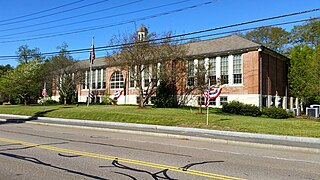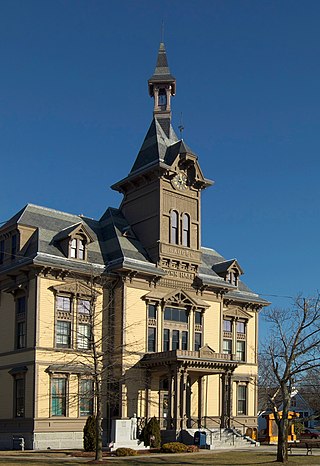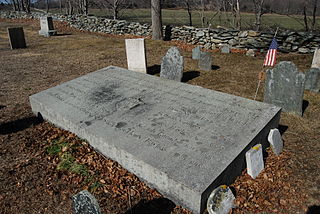
Bristol County is a county in the Commonwealth of Massachusetts. As of the 2020 census, the population was 579,200. The shire town is Taunton. Some governmental functions are performed by the Commonwealth of Massachusetts, others by the county, and others by local towns and cities.

Raynham is a town in Bristol County, Massachusetts, United States, located approximately 32 miles (51 km) south of Boston and 22 miles (35 km) northeast of Providence, Rhode Island. The population was 15,082 at the 2020 census. It has one village, Raynham Center.

Taunton is a city in Bristol County, Massachusetts, United States. It is the seat of Bristol County. Taunton is situated on the Taunton River which winds its way through the city on its way to Mount Hope Bay, 10 miles (16 km) to the south. At the 2020 census, the city had a population of 59,408. Shaunna O'Connell is the mayor of Taunton.

Saugus is a town in Essex County, Massachusetts, United States, in the Greater Boston area. The population was 28,619 at the 2020 census. Saugus is known as the site of the first integrated iron works in North America.

Bridgewater is a town located in Plymouth County, in the state of Massachusetts, United States. As of the 2020 U.S. Census, the town's population was 28,633. Bridgewater is located approximately 25 miles (40 km) south of Boston and approximately 35 miles east of Providence, Rhode Island.

Saugus Iron Works National Historic Site is a National Historic Site about 10 miles northeast of Downtown Boston in Saugus, Massachusetts. It is the site of the first integrated ironworks in North America, founded by John Winthrop the Younger and in operation between 1646 and approximately 1670. It includes the reconstructed blast furnace, forge, rolling mill, shear, slitter and a quarter-ton trip hammer.

Oakland is one of five primary historic neighborhoods of the city of Taunton, Massachusetts. Although these neighborhoods are not census-designated areas, they are municipally designated populated regions of the city.

The Forge River is a 5.1-mile-long (8.2 km) river in the town of Raynham in southeastern Massachusetts. It is a tributary of the Taunton River. It rises from Gushee Pond near Interstate 495 and flows northwest through Titicut Swamp, then turns southwest for the rest of its course. It flows through Hewitt Pond, passes the neighborhood of Tracy Corner, then continues through Johnson Pond and the village of Raynham Center to its junction with the Taunton River.

Samuel Leonard Crocker was a prominent businessman and U.S. Representative from Taunton, Massachusetts. Crocker graduated from Brown University, Providence, Rhode Island, in 1822. Throughout his life, he engaged in various manufacturing and civic interests in his hometown of Taunton and throughout Massachusetts.

The Old Colony Iron Works-Nemasket Mills Complex is a historic industrial site located on Old Colony Avenue in the East Taunton section of Taunton, Massachusetts, United States, adjacent to the Taunton River at the Raynham town line. The site was first occupied by the Old Colony Iron Company, which had originally been established in the 1820s as Horatio Leonard & Company. The western part of the complex was sold to Nemasket Mills in 1889. The eastern part was acquired by the Standard Oil Cloth Company. The site was added to the National Register of Historic Places in 1984.

The Whittenton Mills Complex is a historic textile mill site located on Whittenton Street in Taunton, Massachusetts, on the banks of the Mill River. The site has been used for industrial purposes since 1670, when James Leonard built an iron forge on the west bank of the river. The first textile mill was built in 1805 and expanded throughout the 19th century. The complex was added to the National Register of Historic Places in 1984, and now contains various small businesses.

Thomas Baylies was a Quaker ironmaster first in England, then in Massachusetts.

North Taunton is an unofficial neighborhood in the city of Taunton, Massachusetts. It is not a census-designated area, but is considered by local residents as a municipally designated populated region of the city.

The Rowley Village Forge Site is a historic colonia-era iron foundry site in Boxford, Massachusetts. The first iron forge in the area was established on Fish Brook in 1668 by Henry Leonard of the Leonard family, who were instrumental in the Saugus Iron Works further south. This business ran until about 1681, but the site also saw industrial uses into the 19th century, with sawmills and gristmills quickly replacing the foundry after it failed. Remnants of these works are visible from trails through conservation land off Lockwood Drive.

The John Winthrop Jr. Iron Furnace Site is a historic archaeological site at 61 Crescent Street, Quincy, Massachusetts. The site is called Braintree Furnace in some texts; the West Quincy location at the time of operation was in a part of Braintree, Massachusetts, that later became Quincy. Its importance lies in the fact that it was the first iron blast furnace established in what would become the United States. Furnace Brook, a stream which begins on the eastern slopes of the Blue Hills and meanders for about four miles from southwest to northeast through the middle of Quincy toward Quincy Bay, was named for the works site.
The Dighton and Somerset Railroad, currently referred to as the Dean Street Industrial Track, is a railroad that ran between Fall River and Braintree, Massachusetts. It opened in 1866; from the 1890s to the 1930s and again in the late 1950s, it was the primary rail route from Boston to the South Coast. Passenger service ended in stages with the final regular service in 1958, though freight service on two short segments continues into the 21st century. MBTA Commuter Rail service is proposed to be extended onto the northern part of the line around 2030 as part of the South Coast Rail project.

Samuel Wilbore was one of the founding settlers of Portsmouth in the Colony of Rhode Island and Providence Plantations. He emigrated from Essex, England to Boston with his wife and three sons in 1633. He and his wife both joined the Boston church, but a theological controversy began to cause dissension in the church and community in 1636, and Wilbore aligned himself with John Wheelwright and Anne Hutchinson, signing a petition in support of dissident minister Wheelwright. In so doing, he and many others were disarmed and dismissed from the Boston church. In March 1638, he was one of 23 individuals who signed a compact to establish a new government, and this group purchased Aquidneck Island, then known as "Rhode Island", from the Narragansett Indians at the urging of Roger Williams, establishing the settlement of Portsmouth.

Nahum Stetson was a leading businessman from southeastern Massachusetts during the 19th century. He is best known for his role in establishing the Bridgewater Iron Company as one of the largest iron works in the United States during the mid-1800s. Stetson was also involved in several other iron companies throughout the southeastern New England region, as well as other notable businesses, including banks and railroads. His grandson, Nahum Stetson (1856-1933) was part of the Steinway & Sons piano company, as part of its sales team and board of directors.
Joseph Jenckes Jr., also spelled Jencks and Jenks, was the founder of Pawtucket, Rhode Island, where he erected a forge in 1671.
Joseph Jenckes Sr., also spelled Jencks and Jenks, was a bladesmith, blacksmith, mechanic, and inventor who was instrumental in establishing the Saugus Iron Works in Massachusetts Bay Colony where he was granted the first machine patent in North America.




















